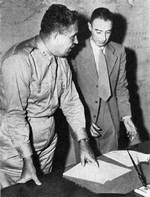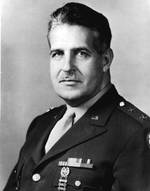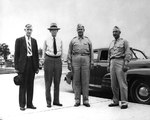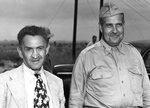Leslie Groves
| Surname | Groves |
| Given Name | Leslie |
| Born | 17 Aug 1896 |
| Died | 13 Jul 1970 |
| Country | United States |
| Category | Military-Ground |
| Gender | Male |
Contributor: C. Peter Chen
ww2dbaseLeslie Richard Groves was born in Albany, New York, United States. He was educated at University of Washington, Massachusetts Institute of Technology, and the United States Academy at West Point. He graduated in 1918 and went on to the Army Corps of Engineers, serving a brief tour of duty in France during World War I. He had a healthy track of promotions during the inter-war years, and in 1940 oversaw a major construction project of building the Pentagon. Despite his personal objections (he had wished for an overseas command) his administrative skills eventually led his 1942 appointment as the military director of the Manhattan Project, along with the war time rank of Brigadier General.
ww2dbaseThe Manhattan Project was a project code name Groves had came up with, and the goal was the United States' effort to create a powerful weapon using the by-product of nuclear fission. In this role, he coordinated efforts at Columbia University in New York City, University of Chicago in Chicago, the Clinton Laboratory at Oak Ridge, Tennessee, the Hanford Engineer Works near Pasco, Washington, and the Los Alamos installation in New Mexico. He appointed Robert Oppenheimer as his scientific peer, a decision surprised by many as the two had such different political views, but the decision ultimately created a good team that pushed the project forth. On 16 July 1945, the US$2,000,000,000 project came to fruition: on that day, Operation Trinity saw the successful test detonation of the world's first atomic weapon nicknamed Gadget. In less than one month, Gadget's siblings Little Boy and Fat Man destroyed Hiroshima and Nagasaki, respectively. Emperor Showa of Japan surrendered shortly after the destruction. During the project, Groves was promoted to the rank of major general in 1944, and remained as the Chief of Army Special Weapons Project until Jan 1947.
ww2dbaseAfter the war, Groves remained in the US Army until his retirement on 29 Feb 1948 at the rank of lieutenant general. He became a vice president at the private engineering firm Sperry Rand Corporation. He passed away of heart disease in 1970, and now rests in peace at the Arlington National Cemetery in Arlington, Virginia, United States.
ww2dbaseSources: Arlington National Cemetery, Wikipedia.
Last Major Revision: Dec 2005
Leslie Groves Interactive Map
Photographs
 |  |  |  |
Videos
 |
Leslie Groves Timeline
| 17 Aug 1896 | Leslie Groves was born. |
| 17 Sep 1942 | Leslie Groves was given charge of overseeing the Manhattan Project. |
| 23 Sep 1942 | Leslie Groves was promoted to the rank of brigadier general. On the same day, he toured the future Oak Ridge site of the Manhattan Project in Tennessee, United States and expressed his satisfaction for this site being used for a future production site. |
| 16 Nov 1942 | Robert Oppenheimer, Leslie Groves, and others toured a prospective site for nuclear research in New Mexico, United States. The site would not be selected due to Oppenheimer's opinion that the surrounding high cliffs would cause claustrophobic and thus lower morale, while engineers were concerned with the possibility of flooding. |
| 16 Jul 1945 | In Operation Trinity, the Americans successfully detonated an atomic bomb at Alamogordo Bombing Range in New Mexico, United States. The test blast created temperatures 10,000 times the surface temperature of the sun and was felt 200 miles away. The explosion was the equivalent of 20,000 tons of TNT and throws a column of fire and smoke 35,000 feet into the night sky. The authorities hid the blast by claiming that an ammunition dump had gone up. |
| 13 Jul 1970 | Leslie Groves passed away. |
Did you enjoy this article or find this article helpful? If so, please consider supporting us on Patreon. Even $1 per month will go a long way! Thank you. Share this article with your friends: Stay updated with WW2DB: |
» Operation Trinity and Manhattan Project
Related Books:
» Bomb
» Countdown 1945
- » 1,150 biographies
- » 337 events
- » 43,917 timeline entries
- » 1,241 ships
- » 350 aircraft models
- » 207 vehicle models
- » 374 weapon models
- » 123 historical documents
- » 260 facilities
- » 470 book reviews
- » 28,540 photos
- » 432 maps
Lt. Gen. Lewis B. "Chesty" Puller, at Guadalcanal
Please consider supporting us on Patreon. Even $1 a month will go a long way. Thank you!
Or, please support us by purchasing some WW2DB merchandise at TeeSpring, Thank you!